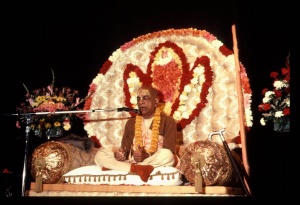CC Madhya 1.64: Difference between revisions
m (1 revision(s)) |
No edit summary |
||
| Line 1: | Line 1: | ||
{{ | [[Category:Sri Caitanya-caritamrta - Madhya-lila Chapter 01|C064]] | ||
<div style="float:left">'''[[Sri Caitanya-caritamrta|Śrī Caitanya-caritāmṛta]] - [[CC Madhya|Madhya-līlā]] - [[CC Madhya 1|Chapter 1: The Later Pastimes of Lord Śrī Caitanya Mahāprabhu]]'''</div> | |||
<div style="float:right">[[File:Go-previous.png|link=CC Madhya 1.63|Madhya-līlā 1.63]] '''[[CC Madhya 1.63|Madhya-līlā 1.63]] - [[CC Madhya 1.65|Madhya-līlā 1.65]]''' [[File:Go-next.png|link=CC Madhya 1.65|Madhya-līlā 1.65]]</div> | |||
{{CompareVersions|CC|Madhya 1.64|CC 1975|CC 1996}} | |||
{{RandomImage}} | |||
==== TEXT 64 ==== | ==== TEXT 64 ==== | ||
<div | <div class="verse"> | ||
mahāprabhu jagannāthera upala-bhoga dekhiyā | :mahāprabhu jagannāthera upala-bhoga dekhiyā | ||
nija-gṛhe yā’na ei tinere miliyā | :nija-gṛhe yā’na ei tinere miliyā | ||
</div> | </div> | ||
| Line 12: | Line 16: | ||
==== SYNONYMS ==== | ==== SYNONYMS ==== | ||
<div | <div class="synonyms"> | ||
mahā- | ''mahā-prabhu''—Śrī Caitanya Mahāprabhu; ''jagannāthera''—of Lord Jagannātha; ''upala-bhoga''—offering of food on the stone; ''dekhiyā''—after seeing; ''nija-gṛhe''—to His own residence; ''yā’na''—goes; ''ei''—these; ''tinere''—three; ''miliyā''—meeting. | ||
</div> | </div> | ||
| Line 19: | Line 23: | ||
==== TRANSLATION ==== | ==== TRANSLATION ==== | ||
<div | <div class="translation"> | ||
Every day Śrī Caitanya Mahāprabhu used to see the upala-bhoga ceremony at the temple of Jagannātha, and after seeing this He used to go visit these three great personalities on His way to His own residence. | Every day Śrī Caitanya Mahāprabhu used to see the upala-bhoga ceremony at the temple of Jagannātha, and after seeing this He used to go visit these three great personalities on His way to His own residence. | ||
</div> | </div> | ||
| Line 26: | Line 30: | ||
==== PURPORT ==== | ==== PURPORT ==== | ||
<div | <div class="purport"> | ||
Upala-bhoga is a particular type of offering performed just behind the Garuḍa-stambha on a stone slab. That stone slab is called the upala. All food is offered within the temple room just below the altar of Jagannātha. This bhoga, however, was offered on the stone slab within the vision of the public; therefore it is called upala-bhoga. | ''Upala-bhoga'' is a particular type of offering performed just behind the Garuḍa-stambha on a stone slab. That stone slab is called the ''upala''. All food is offered within the temple room just below the altar of Jagannātha. This ''bhoga'', however, was offered on the stone slab within the vision of the public; therefore it is called ''upala-bhoga''. | ||
</div> | </div> | ||
__NOTOC__ | |||
<div style="float:right; clear:both;">[[File:Go-previous.png|link=CC Madhya 1.63|Madhya-līlā 1.63]] '''[[CC Madhya 1.63|Madhya-līlā 1.63]] - [[CC Madhya 1.65|Madhya-līlā 1.65]]''' [[File:Go-next.png|link=CC Madhya 1.65|Madhya-līlā 1.65]]</div> | |||
__NOTOC__ | |||
__NOEDITSECTION__ | |||
Revision as of 14:39, 22 July 2021

A.C. Bhaktivedanta Swami Prabhupada
TEXT 64
- mahāprabhu jagannāthera upala-bhoga dekhiyā
- nija-gṛhe yā’na ei tinere miliyā
SYNONYMS
mahā-prabhu—Śrī Caitanya Mahāprabhu; jagannāthera—of Lord Jagannātha; upala-bhoga—offering of food on the stone; dekhiyā—after seeing; nija-gṛhe—to His own residence; yā’na—goes; ei—these; tinere—three; miliyā—meeting.
TRANSLATION
Every day Śrī Caitanya Mahāprabhu used to see the upala-bhoga ceremony at the temple of Jagannātha, and after seeing this He used to go visit these three great personalities on His way to His own residence.
PURPORT
Upala-bhoga is a particular type of offering performed just behind the Garuḍa-stambha on a stone slab. That stone slab is called the upala. All food is offered within the temple room just below the altar of Jagannātha. This bhoga, however, was offered on the stone slab within the vision of the public; therefore it is called upala-bhoga.